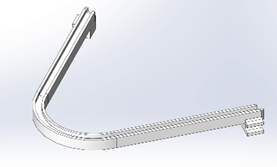

Bioabsorbable Cranial Springs for Craniosynostosis
A University of Pittsburgh researcher has developed a bioabsorbable cranial spring to treat craniosynostosis. Developed using co-polymer blends of poly(lactic-co-glycolic acid) (PLGA), these springs consist of bioabsorbable plates and screws. These novel springs could offer clinicians alternatives to current stainless steel springs which must be surgically removed. Full development of cranial springs that dissolve in situ over time could allow for successful, less invasive treatment of craniosynostosis in children.

Description
Newborn babies have joints comprising of flexible, fibrous tissue between the skull’s bones to allow for growth of the baby’s brain before becoming fully fused in adolescence. Craniosynostosis is a birth defect where one or more cranial sutures is fused at or shortly after birth and can limit the development of the child’s brain. Sagittal craniosynostosis (SC), where the sagittal suture is fused, accounts for almost half of all craniosynostosis cases. SC, like other craniosynostosis cases, often results in a misshaped head as the remaining open sutures attempted to compensate by growing faster. Limited skull growth can result in increased intracranial pressure leading to headaches, developmental delay, and blindness. There is a need to develop treatment for SC requiring less surgical interventions. These novel cranial springs could revolutionize the treatment of SC, removing the need for multiple surgeries.Applications
• Sagittal craniosynostosis• Other craniosynostoses
Advantages
Current treatment for CS ranges from extensive surgery to completely reshape the skull, a highly invasive procedure requiring a long hospital stay, through to removal of the fused suture followed by post-operative passive remolding of the skull using a specially designed helmet. However, helmet compliance is very poor (<20%) and can place additional pressure on the brain. An alternative approach involving cranial springs to mimic the removed suture (i.e., spring-assisted cranioplasty) has become increasing popular. While effective, this process requires further operations for surgical removal of the springs exposing patients to additional anesthetic and associated risks from surgery.Using PLGA blends, currently approved by the FDA for use in medical devices, these novel cranial springs are bioabsorbable, removing the need for surgical removal. A unique H-beam design has been developed to ensure the PLGA springs have comparable strength to stainless steel springs and reduce the amount of PLGA required leading to faster degradation in situ. Finally, these springs have a novel foot plate design that distributes spring forces more evenly across the skull, reducing the risk of skull shearing.
Invention Readiness
Prototypes were 3D printed. Mechanical studies confirmed the novel springs had comparable spring force to existing stainless steel springs. Further work is now required to optimize the design and perform in vivo testing in animals.IP Status
https://patents.google.com/patent/WO2023215156A1Related Publication(s)
Bykowski, M. R., Goldstein, J. A., & Losee, J. E. (2019). Pediatric Cranioplasty. Clinics in plastic surgery, 46(2), 173–183. https://doi.org/10.1016/j.cps.2018.11.003